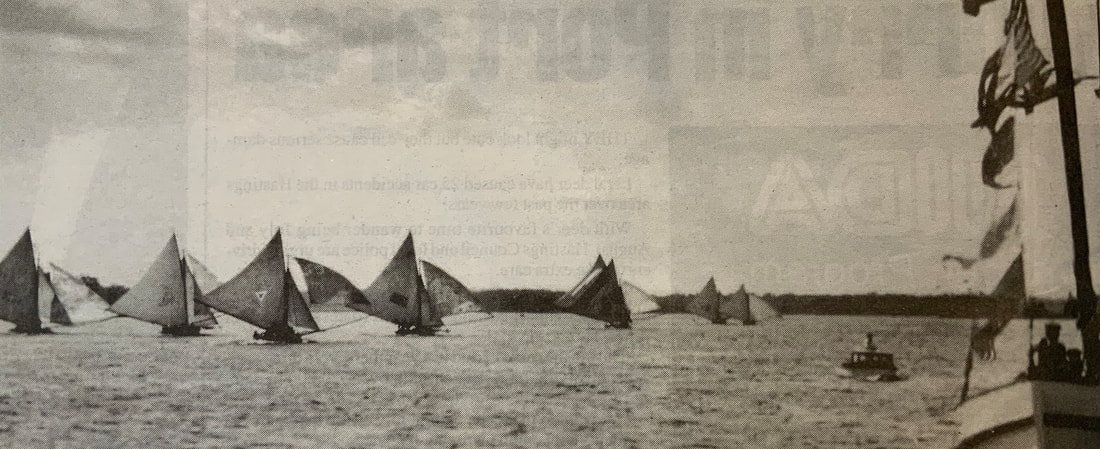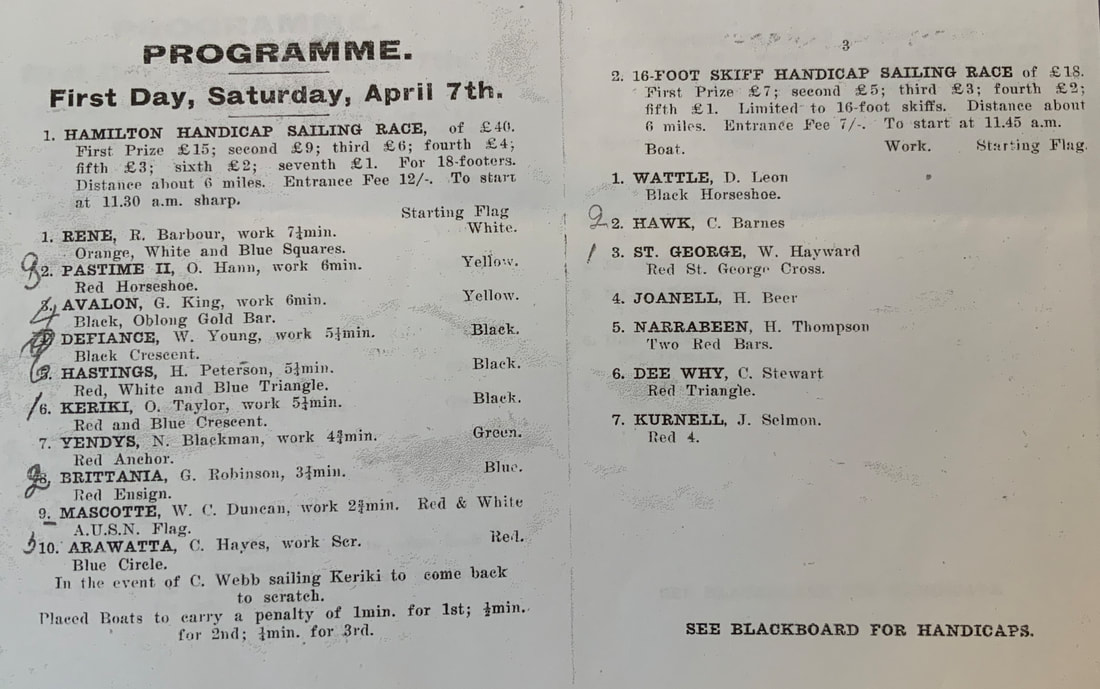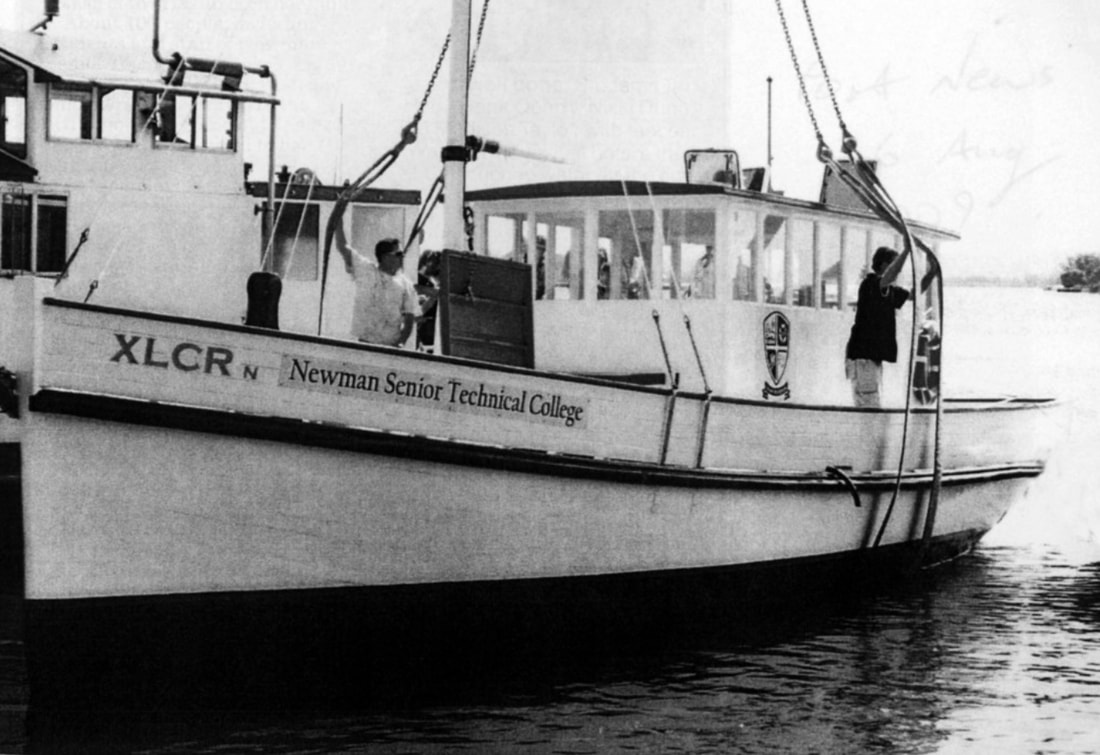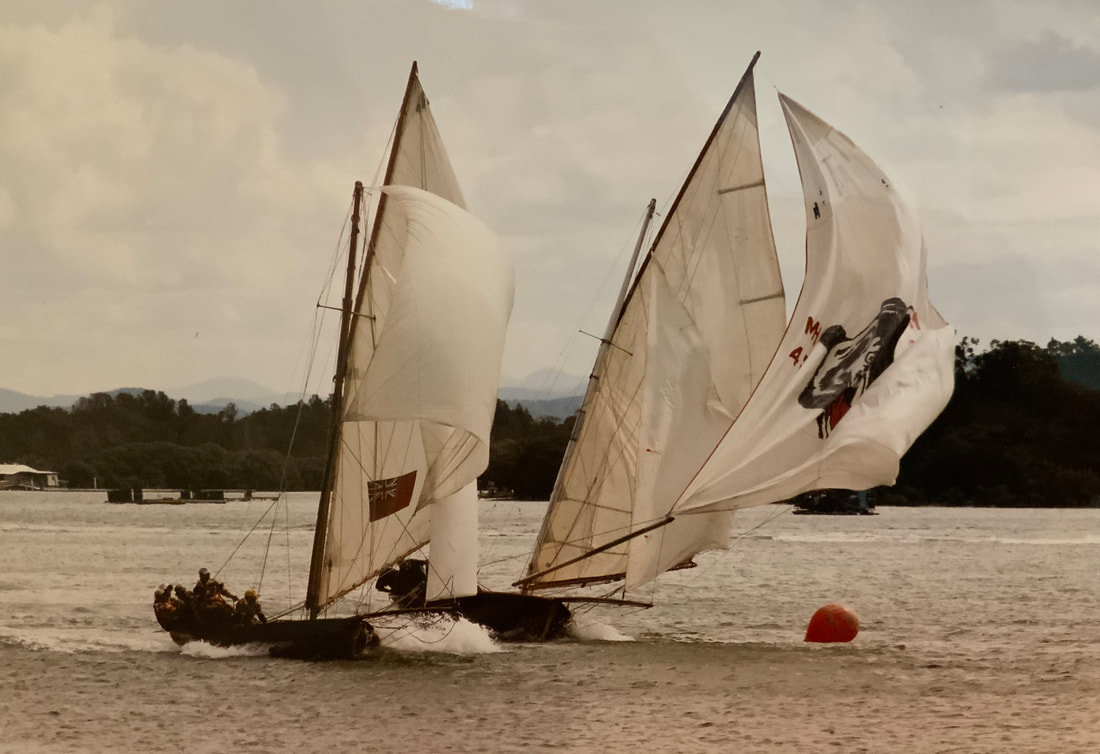The town of Port Macquarie on the North Coast of NSW held an annual Regatta at Easter during the 1920’s and ‘30’s that was attended by many Sydney 18-footers. The considerable prize money offered was a big attraction.
There had been local regattas before World War One involving local fishing and pleasure craft, held down in the Port area. After the breakwaters were built that area began to fill up with sandbanks, and the Regattas after that were held up the Hastings River at Settlement Farm, now McInerney Park. The Regatta was revived on Easter Monday April 5 1920. Eight 18-footers took part. Five boats travelled up from Sydney, Mascotte, Kismet, Advance, Sydney and Rocket. There were three local boats, Scot (the former Sydney boat now owned by a Port Macquarie local) plus Hastings and Australia (not Bill Fisher’s Australia, not built until the following year). WJ Billy Duncan steered Mascotte to victory.
There had been local regattas before World War One involving local fishing and pleasure craft, held down in the Port area. After the breakwaters were built that area began to fill up with sandbanks, and the Regattas after that were held up the Hastings River at Settlement Farm, now McInerney Park. The Regatta was revived on Easter Monday April 5 1920. Eight 18-footers took part. Five boats travelled up from Sydney, Mascotte, Kismet, Advance, Sydney and Rocket. There were three local boats, Scot (the former Sydney boat now owned by a Port Macquarie local) plus Hastings and Australia (not Bill Fisher’s Australia, not built until the following year). WJ Billy Duncan steered Mascotte to victory.
18-footers at the Port Macquarie Regatta in 1930, several local boats but mostly from Sydney. Photo printed in the Port Macquarie Express News in 2004.
The following year they ran it over Easter Saturday and Monday, with a handicap race and a Championship. It was actually classed as the NSW Championship for 1921 as the earlier attempt to run that Championship in Sydney was abandoned in a drifter. Billy Duncan won it again, this time in Kismet from a fleet including Mascotte, Hastings, Golding, Keriki, Scot and Advance.
By 1923 the Regatta was running over three days with three or four races, always including a Championship race which was variously called the Hastings River Championship or the North Coast Championship. That year they offered 50 pounds prize money per day and this attracted 12 starters including Chris Webb in HC Press II who after this became a regular attendee and won the Championship 5 times, twice in HCPress and three times in Keriki, but not on this first trip when it was won by the local boat Hastings. From the early Regattas other sailing classes, sculling boats and particularly motor boats also had races each day.
By 1923 the Regatta was running over three days with three or four races, always including a Championship race which was variously called the Hastings River Championship or the North Coast Championship. That year they offered 50 pounds prize money per day and this attracted 12 starters including Chris Webb in HC Press II who after this became a regular attendee and won the Championship 5 times, twice in HCPress and three times in Keriki, but not on this first trip when it was won by the local boat Hastings. From the early Regattas other sailing classes, sculling boats and particularly motor boats also had races each day.
Pages from the Regatta programme in 1928. Notice the handicap for Keriki....5 1/4 minutes if Lan Taylor steers, scratch if Chris Webb steers. Several 16-footers travelled up from Sydney as well. W."Billo" Hayward was a legend in 16's in the 1920's and 1930's and in the 18's in the late 1930's and '40's. Author"s collection.
The prize money increased to 50 pounds just for the Championship race by 1926 and by 1927 there was a total of 300 pounds in prizes, and the SFS gave a subsidy of 5 pounds to Sydney boats traveling up. The boats travelled by the weekly steamer and were lifted into the Port by the ship’s cranes, and were towed up to the Regatta grounds. After 1927 this service was performed by the local trawler XLCR, which has been restored by the local North Coast Maritime Museum and still sails on the River. Crews mostly travelled up by train, and were entertained by the locals at social events as well as the racing, including a feast of oysters and beer on Easter Sunday when there was no racing. A large group of supporters also travelled up, and all were full of praise for the hospitality of the locals.
Local trawler XLCR which towed the Sydney boat from the Port to the upriver regatta grounds from 1927. The boat has been restored by the North Coast Maritime Museum. Photo Warren Bridge, Newman Senior Technical College.

Entries peaked in the mid-1920’s with up to ten Sydney boats making the trip competing with up to four local boats. The local fleet was based on the Hastings and the Macleay Rivers, and met several times a year for a local competition. Apparently at least one of the local boats was crewed by sailors from the local indigenous community.
During and after the Depression the prize money was reduced but 5 or 6 Sydney boats made the trip up each year, aided by a subsidy from the Regatta committee of 30 pounds per boat, augmented by 25 pounds per boat from the SFS. This was at a time when a tally clerk’s wages were between 3 pounds 19 shillings and 4 pounds 8 shillings per week.
Above: One of several framed photos from the Regatta at the South West Rocks Seabreeze Hotel. Keriki and Britannia were two of the most regular Sydney boats to attend.
A problem arose from time to time when the often light weather on this coast at Easter time meant that races were called off. The Championship was no race in 1930 and 1935. Wee Georgie Robinson’s Britannia became a regular attendee from 1927 and won in both 1934 and 1936, and was leading in the 1935 race when it was called off when the time limit was reached. Other winners than the ones mentioned included Lifesaver, Yendys, and Kiwi.
The Regatta committee was apparently disappointed in the slowly decreasing number of 18’s making the trip up from Sydney and declined to hold an 18-footers event in the 1937 Regatta. Instead the 16-footers provided the chief event. This was repeated in 1938 but the Regatta lapsed after that. It was revived in 1948 but no 18’s were involved.
In 2004 Sydney Flying Squadron historian John Steamer Stanley received a silver cup as a donation to the SFS by Frank Messingham a grandson of Lan Taylor the owner of Keriki who had won the Championship in 1927, 1929 and 1931 with Chris Webb at the helm. At that time there was a tradition that if you won a cup three times it was given to you. It was in the shape of an egg cup with a silver egg that opened. Apparently Mark Foy would put four sovereigns in there as part of the winner’s prize. The cup now lives in the trophy cabinet at the Sydney Flying Squadron. I will post a photo of it once the club is open again.
During and after the Depression the prize money was reduced but 5 or 6 Sydney boats made the trip up each year, aided by a subsidy from the Regatta committee of 30 pounds per boat, augmented by 25 pounds per boat from the SFS. This was at a time when a tally clerk’s wages were between 3 pounds 19 shillings and 4 pounds 8 shillings per week.
Above: One of several framed photos from the Regatta at the South West Rocks Seabreeze Hotel. Keriki and Britannia were two of the most regular Sydney boats to attend.
A problem arose from time to time when the often light weather on this coast at Easter time meant that races were called off. The Championship was no race in 1930 and 1935. Wee Georgie Robinson’s Britannia became a regular attendee from 1927 and won in both 1934 and 1936, and was leading in the 1935 race when it was called off when the time limit was reached. Other winners than the ones mentioned included Lifesaver, Yendys, and Kiwi.
The Regatta committee was apparently disappointed in the slowly decreasing number of 18’s making the trip up from Sydney and declined to hold an 18-footers event in the 1937 Regatta. Instead the 16-footers provided the chief event. This was repeated in 1938 but the Regatta lapsed after that. It was revived in 1948 but no 18’s were involved.
In 2004 Sydney Flying Squadron historian John Steamer Stanley received a silver cup as a donation to the SFS by Frank Messingham a grandson of Lan Taylor the owner of Keriki who had won the Championship in 1927, 1929 and 1931 with Chris Webb at the helm. At that time there was a tradition that if you won a cup three times it was given to you. It was in the shape of an egg cup with a silver egg that opened. Apparently Mark Foy would put four sovereigns in there as part of the winner’s prize. The cup now lives in the trophy cabinet at the Sydney Flying Squadron. I will post a photo of it once the club is open again.
Britannia and Tangalooma at the wing mark at the regatta revival at Easter 2005. A great shot by Denise Sinclair.
Steamer began to research the Regatta and suggested a re-enactment or revival to people he contacted there. The Australian Historical Sailing Skiff Association got involved. The Port Macquarie Sailing Club is based at McInerney Park the old Regatta grounds and they were keen to be involved as was local figure the late Bruce Jordan who discounted his caravans and cabins on site. It was held over Easter in 2005. Six of the then seven historical 18’s of the replica fleet travelled up as well as ten 10-footers, six from NSW and four from Queensland. Over three handicap races for each fleet in conditions varying from a near-gale to a drifter, Commonwealth was the overall winner in the ten-footers, Britannia in the 18-footers.
Next year is the bi-centenary of the founding of Port Macquarie, and at this early stage there is a possibility that some of the replica fleet May travel up to display or sail during the festivities.
Next year is the bi-centenary of the founding of Port Macquarie, and at this early stage there is a possibility that some of the replica fleet May travel up to display or sail during the festivities.



